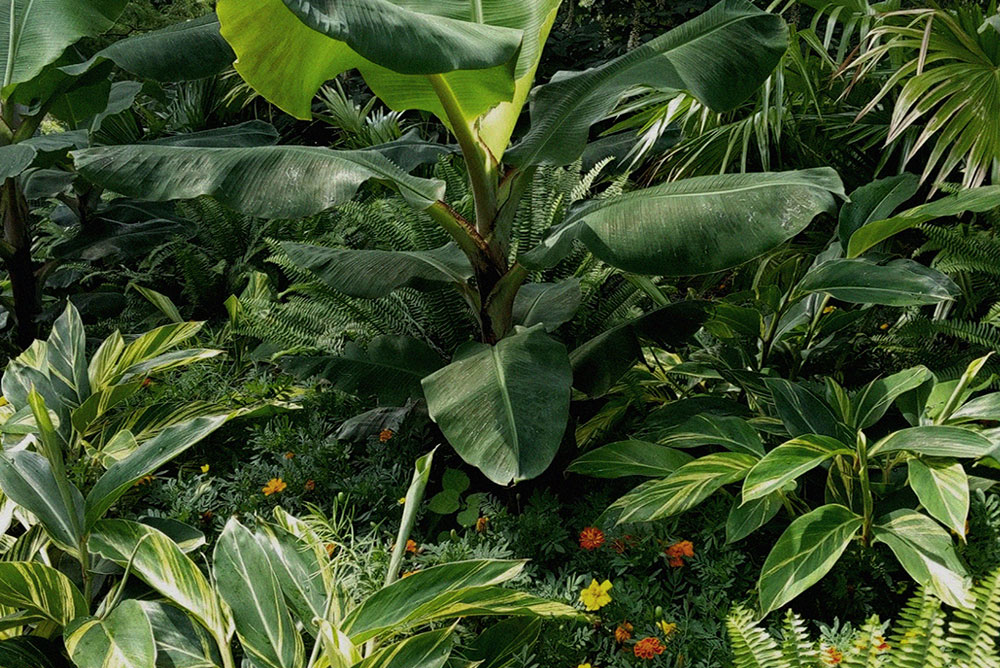
The National Zoo in Washington DC has pandas, yes, but it also has plantings that rival those adorable critters. Here it’s a combo of bananas, ferns and palms, with a few marigolds tossed in to discourage other wildlife, meaning the mosquitoes. / Photo by Stephanie Cavanaugh.
By Stephanie Cavanaugh
SHADE GARDENS don’t happen overnight. They creep up on you.
Say you have a little plot, naked as the day it was born. The sun shines brightly from dawn to dusk—oh, the excitement of what to plant! You dig and turn and add this and that, throw in a curving path and say, if you’re me, for instance . . .
Oh, wouldn’t a cherry tree look dandy right there.
So you buy a nice healthy Kwanzan, perhaps, and you do know (because you read the tag) that they grow to 30 or 40 feet with a similar spread, which would completely cover the garden. But that takes years and years and you say . . .
This is our starter home. We won’t be here that long—and won’t it be pretty in spring. When we do sell, we should plan for April when the tree will be at its utmost double-pink fabulousness.
So the tree is planted, and underneath you set bulbs, and along the walls you plant roses and clematis, and there are tulips in spring, and by summer patches of zinnias and cosmos and baskets of petunias in a birthday-card riot of colored petals.
And a decade or two passes and somehow or other you’re still here and the tree is now 30 feet tall (with a similar spread) and the roses . . . well . . . And forget the zinnias, just forget about them. And you think . . .
Flowers are so tacky, aren’t they? All those florid colors, particularly in July when day after day the temperature soars into the 90s and you drip from lifting the newspaper off the front porch. Isn’t green nice? Didn’t we all love the idea of the Emerald City? Ha-ha-ha! Ho-ho-ho! And a couple of tra-la-las.
That’s how we laugh the day away, in the merry old land of Oz.
That was an aside.
As we get older, we get wiser and also come up with more excuses for not doing or not having done something. Opinions morph to suit the circumstances.
There are so many shades of green, so many shapes of leaf. To somewhat simplify, there are light greens, dark greens, big leaves, small leaves. Some are frilly, some stand erect like arrows, striated in color—those would be called mother-in-law’s tongue, which you could ask my son-in-law to explain.
You might create a garden that looks as if it belongs in Maine, with hostas, ivy, pachysandra, juniper, lily of the valley and begonias. Large hats and flower-sprigged voile dresses go well with these. Lemonade would be nice.
Or play off the miserably hot, humid weather with tropicals, or tropical-feeling, plants such as elephant ears, palms, ferns, Schefflera, jasmine and bananas. Wear a Panama hat and smoke a panatela—or try a caftan.
If the tree is deciduous, baring its branches each fall, there will probably be enough sun for a weak display of whatever early spring flowers you particularly covet—and really, aren’t these the nicest flowers of the year? They may not grow to the scale they would in a sunny garden, but you can have roses and a fine display of tulips before the shade returns, each year mightier than the year before.
Be positive! Isn’t it nice to be able to ignore the directive “needs 6 to 8 hours of direct sun,” which you don’t have now and never will?
Unless you take an axe . . .

Unfortunately, no matter what I do, I just don’t do gardens, though columns like this make me want to try. Thanks.